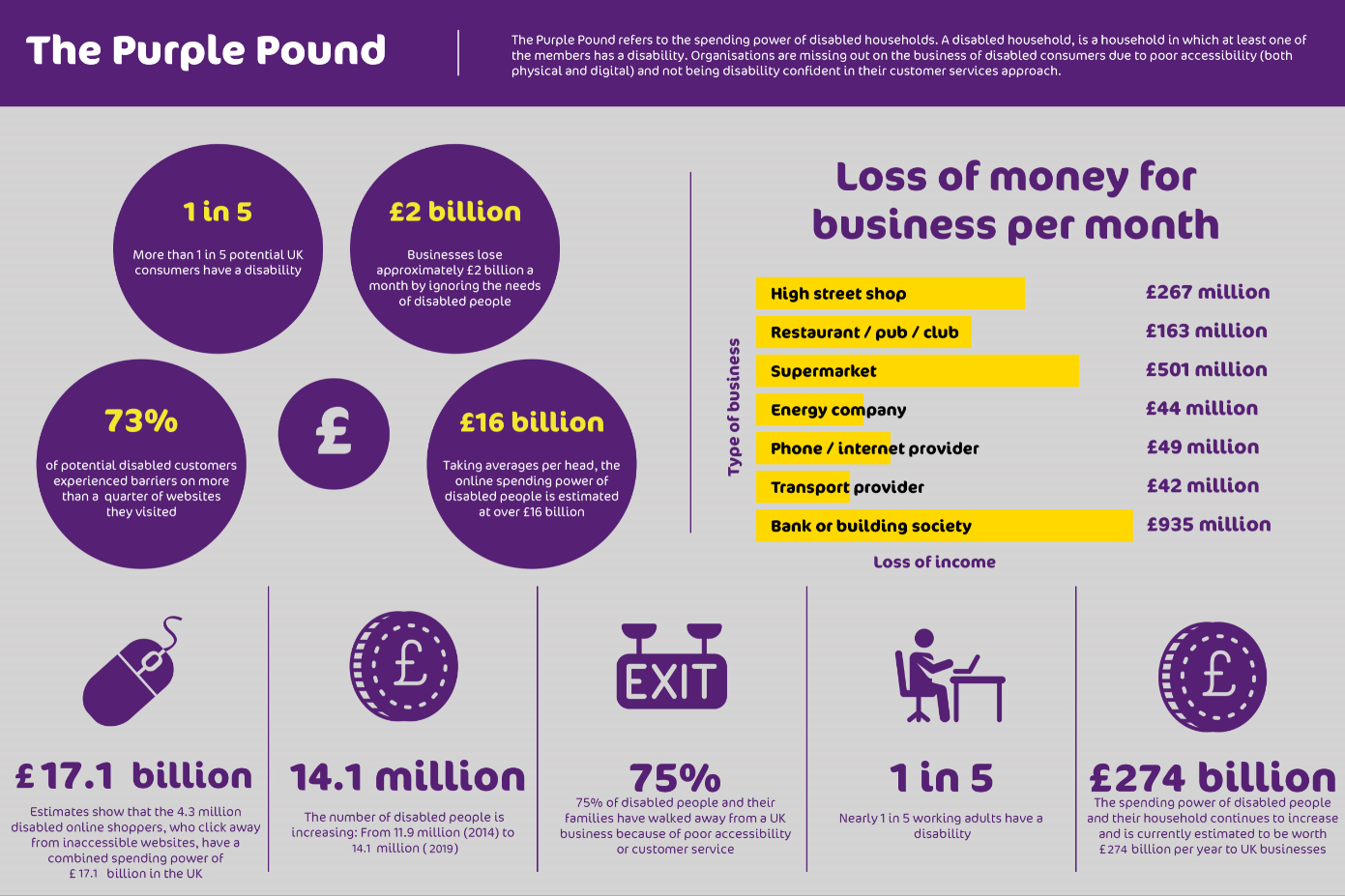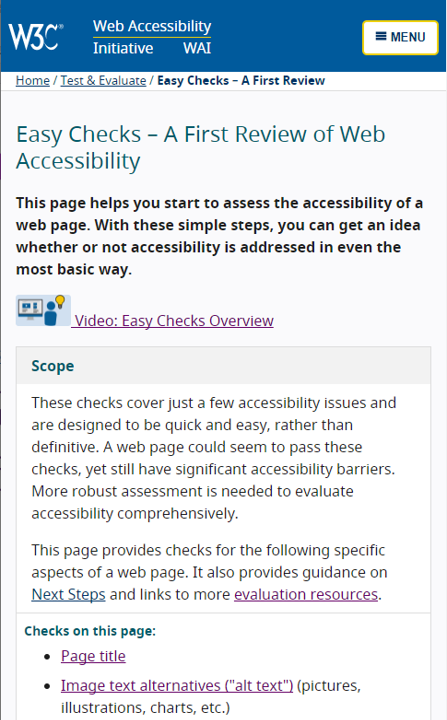Building a business case for accessibility
Foundations of your business case
Building a business case for accessibility
This is the fourth of five modules in the self-led Building a business case for accessibility course.
- Introduction to accessibility
- Accessibility and your organisation
- What is a business case
- Foundations of your business case
- Resources and research
About 15 minutes
Foundations of your business case
Identifying the need
A business case for accessibility can focus on a single product, or on a specific need.
This may include training, budget for suppliers, budget for hiring people with accessibility knowledge, specialist tools such as assistive technologies, or anything else needed to help you achieve your objective.
While a business case for accessibility is usually optimal at the start of a new project, it can also be used to amplify existing accessibility efforts, bring in a new resource, or update the scope of a project.
The three foundations of a business case for accessibility
Every business case is different, as every project and company is different, but there are three foundations to a successful business case for accessibility:
- Your company: how you present accessibility internally
- Justifying the business case: backing up your business case with facts and market research
- Goals and benefits of your business case: what challenges you hope to solve and how these will help the business as well as your customers
Let's explore each in more detail.
Your company
A successful business case for accessibility is one that internal stakeholders can understand, and understand the benefits of.
The business case should also peak to your company vision and values.
Your company: internal stakeholders
It is important to make sure that the business case for accessibility is targeted at all stakeholders, regardless of their specialist knowledge or backgrounds.
This is because some people will be familiar with accessibility, but for others it will be new. For example, stakeholders may include Product Owners and Line Managers, all the way through to Finance Directors, Heads of Digital and the Chief Operating Officers.
Your web accessibility journey starts with your business case, so it should be written in plain English and delivered in an accessible format such as an accessible PDF, Word or PowerPoint document. This will ensure that stakeholders with disabilities can also read the business case.

Your company: vision and values
It's important to relate the business case back to your company's vision and values. These will be specific to your company, but there are common themes you can extract to make your case.
For example, does your vision statement reference words like "inclusion", "everyone", "together" or "making a difference"?
All these are keywords you can pull out to use as justification for the case of accessibility.
Expand the following for examples.
Tumblr's vision
Tumblr is a popular social media blogging site with 327 million unique visitors a day.
Their vision statement is:
“To empower creators to make their best work and get it in front of the audience they deserve.”
There are some keywords that can be used to support a business case for accessibility:
- Empower: everyone, disabled and non-disabled, should be empowered by inclusive, user-friendly design; you cannot empower someone if they can't access the product
- Best work: for example, disabled content creators must be able to access a platform that supports them in doing their best work
- The audience they deserve: everyone, disabled and non-disabled, deserves to be able to create and access content

Nike's vision
Nike is one of the biggest sportswear brand in the world, with a clear vision statement:
“Bring inspiration and innovation to every athlete in the world. [If you have a body, you are an athlete.]”
There are some keywords that can be used to support a business case for accessibility:
- Inspiration: if a company chooses to exclude people by design, how can they be viewed as inspirational; a key part of inspiring new audiences is to see themselves reflected in a brand
- Innovation: innovative sports clothes and shoes should also support disabled athletes
- If you have a body, you are an athlete: this includes everyone, professional and non-professional athletes, as well as disabled professional and non-professional athletes alike. In other words everyone

Your company: vision and values
Like a company vision, company values guide the way a company does business. They sum up what your business stands for, influences organisational culture, and drives how and why you do things.
Common example of values are:
- Respect
- Fairness
- Sustainability
- Excellence
- Teamwork
- Trust
- Integrity
Looking inwards towards your company's core values will serve as a great tool to reference and guide you in the writing of your business case for accessibility.
For example, if you have a value of "Fairness", then you should be treating everyone with the common decency we all deserve and expect. This means people with disabilities should be both included and have their needs met. This can then be referenced in your business case.

Exercise: your vision and values
Either look up your company's vision statement and core values or look at the vision and values for American Express.
- What words or phrases stand out?
- How could you use these to advocate for accessibility?
Expand to reveal the answer
American Express's vision refers to "customer experience":
Provide the world’s best customer experience every day.
In order to provide the best customer experience, every customer must be considered including disabled customers.
The values also comfortably map to inclusion, in particular the following ones:
- We win as a team: the company is open to different ideas from colleagues, customers and the world
- We do what's right: in order to do what's right, products and services must be accessible
- We respect people: in order to respect people, you must respect the needs of everyone
- We need different views: they are a diverse and inclusive company, and serve diverse customers
- We care about our communities: communities comprise people with different abilities and needs, all should be considered
Justifying the business case
It may seem obvious why accessibility is important. It is the right thing to do and is also a legal requirement in most countries. However, you will still need to provide context and justify why your company should invest in accessibility, otherwise you wouldn't be writing a business case.
There may be market research you can reference, legal requirements your company must meet, or internal policies you can use.
Let's look at a few examples.
Justifying the business case: your customers
First and foremost are your customers.
As well as introducing who your disabled customers are, covered in Module 1 introduction to accessibility, it is helpful to put this into the context of your business and how important they are for your business.
The World Health Organisation estimates that people with disabilities make up at least 15% of the global population.
It's worth noting that this figure is known to be an underestimate as it does not include cognitive disabilities, reading and literacy difficulties, age-related disabilities, or many others.

The Purple Pound refers to the spending power of disabled households and is estimated to worth around £249bn to the UK economy. Companies that have inaccessible products or services will not benefit from this key part of the market share.
According to We Are Purple, more than 1 in 5 potential UK consumers have a disability. Estimates also show that the 4.3 million disabled online shoppers who click away from inaccessible websites have a combined spending power of £11.75 billion in the UK.
While this research is UK-focused, the amount of people with disabilities in the general population is a similar percentage across Europe and North America.

Expand for a text description
Research has shown how various sectors lose money each month by not being accessible. A breakdown can be found below:
The Purple Pound refers to the spending power of disabled households. A disabled household is a household in which at least one of the members has a disability. Organisations are missing out on the business of disabled consumers due to poor accessibility (both physical and digital) and not being disability confident in their customer services approach.
- More than 1 in 5 potential UK consumers have a disability.
- Businesses lose approximately £2 billion a month by ignoring the needs of disabled people
- 73% of potential disabled customers experience barriers on more than a quarter of websites they visited
- Taking averages per head, the online spending power of disabled people is estimated at over £16 billion
- Estimates show that the 4.3 million disabled online shoppers, who click away from inaccessible websites, have a combined spending power of £11.75 billion in the UK
- The number of disabled people is increasing: From 11.9 million (2014) to 13.3 million (2020)
- 75% of disabled people and their families have walked away from a UK business because of poor accessibility or customer service
- Nearly 1 in 5 working adults have a disability
- The spending power of disabled people and their household continues to increase and is currently (2020) estimated to be worth £274 billion per year to UK business
Research has shown how various sectors lose money each month by not being accessible, for example:
- High Street Shops: £267 million
- Restaurants/Pubs/Clubs: £163 million
- Supermarkets: £501 million
- Energy Companies: £44 million
- Phone/Internet Providers: £49 million
- Transport Providers: £42 million
- Banks or Building Societies: £935 million
Justifying the business case: your competition
People with disabilities are often loyal to brands that get accessibility right, because they have a good experience when using their products or services.
If your competition makes their products and services accessible for people with disabilities, but you don't, you are at a disadvantage and will lose market share.
As part of your business case, consider doing some market research into your industry to see how well you do in comparison.
Expand the following to find out more.
Review competitor websites and applications
You can learn a lot from looking at a competitor's online presence. For example, look for an Accessibility Conformance Statement on their website, blog posts or articles about accessibility initiatives they may be doing, accessibility help and support pages, and frequently asked questions.
You can also do some accessibility checks yourself of some pages. The W3C Easy Checks are a set of 10 basic accessibility tests put together by the World Wide Web Consortium (W3C) Web Accessibility Initiative (WAI). Their goal is to provide people new to accessibility with a simple way to assess the accessibility of web content.
Find out more about testing sites for accessibility with the TetraLogical Quick accessibility tests video series.

Industry reports on accessibility
White papers, annual reports, webinars, and published research are a good way of understanding what the current accessibility insights and trends are. These will change year-on-year, but a useful one to reference is The State of Digital Accessibility 2022 Survey Report from Level Access. This is an annual report on accessibility programmes and trends in the USA, but is relevant to all countries and covers all industries.
The UK Government does annual Accessibility monitoring of public sector websites and mobile apps, which is useful if you work in local or central UK government.
Justifying the business case: laws and regulations
In many countries, organisations have a legal responsibility to make sure their site is accessible.
It can be costly, time-consuming and reflect badly on your company if these standards are not met and a legal case is brought against you.
The laws and regulations for various countries include:
- Equality Act; UK
- Disability Discrimination Act; Northern Ireland
- Americans with Disabilities Act (ADA); USA
- Rehabilitation Act, Section 508; USA
- Disability Discrimination Act; Australia
- Accessibility for Ontarians with Disabilities Act (AODA); Canada
- Accessibility Act; European Union (EU)
- Public Sector Accessibility Directive; EU
For more information about legislation in different countries read Forbes' Guide To International Web Accessibility Laws And Policies.

Justifying the business case: laws and regulations
Failing to have a compliant product brings a higher legal risk and with it financial and reputational costs.
A study by The Next Web estimated that companies who receive an accessibility-related legal complaint in America often spend in the region of $10,000 looking into it internally. For example, the hours spent by customer services, regulatory personnel, product management, developers, quality assurance and operations staff unpicking what the accessibility issue is during meetings as well as carrying out assessments, implementing fixes, and liaising with the complainant can add up.
Legal costs could cost upwards of $350,000.
Neither of these numbers take into account the damage to your brand and reputation, which is where the real cost lies.
Justifying the business case: internal policies
Your company may already have some policies in place that can support your business case. These could be policies that directly or indirectly reference accessibility.
Expand each to find out more.
Equality, Diversity and Inclusion policy (EDI)
Many companies have an Equality, Diversity and Inclusion policy (EDI) which states the company's commitment to ensuring an equitable, diverse, and inclusive workplace. EDI policies cover people from all backgrounds including people with disabilities, a range of ages, race, gender, sexual orientation, religion, education, socioeconomic status, and geographical location.
If your company doesn't have a formal one, read more about them in this guide by The CIPD to Equality, diversity and inclusion (EDI) in the workplace.
Accessibility policy
Some companies have an accessibility policy which is an internal document that describes the company's strategy and roadmap for implementing accessibility. This could be for its digital products such as websites and mobile applications, as well as built environment such as the workplace and stores.
Accessibility Conformance Report
An Accessibility Conformance Report (ACR) is a document that formally summarises the extent to which an information and communications technology (ICT) product or service conforms to an agreed set of international accessibility guidelines and standards. These are updated annually and may be published on your company website.
Read more in Introduction to Accessibility Conformance Reports
In the same way company as vision and values, these can also be used to further your case for accessibility.
Justifying accessibility: cost
Whether you are looking to secure support from an accessibility consultancy to help deliver your accessibility strategy, buy accessibility testing tools and assistive technologies, or recruit people with accessibility skills, it is a good idea to gather costs and quotes and include these in your business case.
You can then justify the costs by offsetting it against the costs of a legal threat and costs of remediating products that launch with no accessibility in mind.

Goals and benefits for your business case
Have clear, defined accessibility goals that the business case seeks to achieve and what the benefits are to the business as well as your customers.
For every point you make, you must answer the question: why are the company's resources being spent on this?
Remember: the more defined the goals, the more effective the business case will be at achieving them.
Let's explore some common goals and benefits.
Upskilling teams
If your goal is to upskill teams, and you are looking to secure budget for training, you could put in a business case for self-led training and accessibility training programmes.
Self-led training supports continuous accessibility skills development for your teams helping them make accessibility part of everything they do. Self-led training also helps you train teams at scale and keeps knowledge within the organisation even when people leave.
Accessibility training programmes help give your teams advanced training, so they not only know how to design, build, and test accessible products but also understand how to embed accessibility into process.
Accessibility pilots and programmes
It may be that rolling out an accessibility programme across all your products at once isn't possible.
In this case, you might want to invest in making one product accessible. From there you can learn what works and what needs changing, then build out processes throughout the rest of the organisation with a goal of eventually creating an accessibility programme.
Sustainable accessibility
Perhaps your goal is to make sustainable accessibility an integral part of your business and reduce reliance on consultancy support which can be costly over time.
With some initial investment in upskilling teams, recruiting people with accessibility skills in-house, and putting in place processes to make accessibility part of the product development lifecycle, you can reduce both product implementation and remediation costs over time as well as legal risk.
Quiz
A business case for accessibility is a detailed, technical document.
Quiz
A business case for accessibility is a detailed, technical document.
Correct answer: False
It is important to make sure that the business case for accessibility is targeted at all stakeholders, regardless of their technical knowledge or backgrounds.
This is because some people will be familiar with accessibility, but for others it will be new. For example, stakeholders may include Product Owners and Line Managers, all the way through to Finance Directors, Heads of Digital and the Chief Operating Officers.
Quiz
Accessibility must be added to your company vision or values.
Quiz
Accessibility must be added to your company vision or values.
Correct answer: False
Accessibility does not need to be added to your company vision or values. However, it's useful to relate the business case back to your company's vision and values because they guide the way a company does business. They sum up what your business stands for, influences organisational culture, and drives how and why you do things. If your company vision and values can reinforce the business case it makes it easier for stakeholders to understand how important accessibility is.
Quiz
Once you have presented your business case for accessibility and got buy-in from internal stakeholder, then you can secure budget.
Quiz
Once you have presented your business case for accessibility and got buy-in from internal stakeholder, then you can secure budget.
Correct answer: False
It's a good idea to gather costs and quotes for accessibility up front so that stakeholders can make an informed decision. You can then justify the costs by offsetting it against the costs of a legal threat and costs of remediating products that launch with no accessibility in mind.
Summary
In this module you've learned about what can be included to help build a business case for accessibility.
You should aim to complete all five modules of the self-led Building a business case for accessibility course.
- Introduction to accessibility
- Accessibility and your organisation
- What is a business case
- Foundations of your business case
- Resources and research